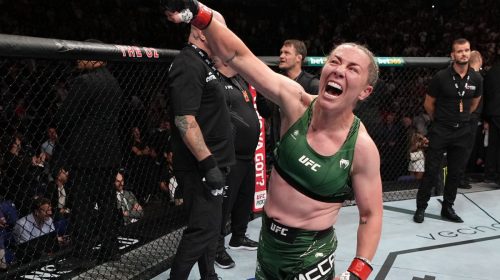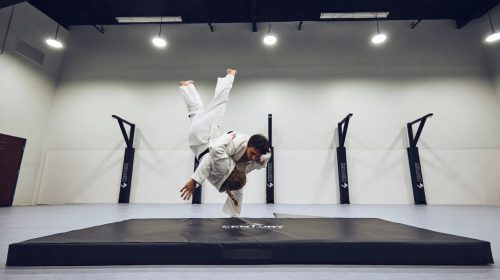
ADCC Rules Have Been Updated, New Website Launched
ADCC head organizer, Mo Jassim, has created a new ADCC website. The new website, ADCC-official.com, includes the updated ADCC rules for the 2022 ADCC World Championships. ADCC will be held in Las Vegas on September 17th and 18th at the Thomas & Mack Center.
Below are the rules and a detailed video of Jassim and head judge Peter Baltaliyski covering the rules at seminar last month.
ADCC Rules and Regulations
Overview
• Gi, Wrestling shoes are optional.
• No slippery substances allowed on body or clothing.
• The mat area is 10 x meters, no cage or fence.
• If the fighters go out of this area, the referee will restart the fight in the center of the mat, in the same position they were when they left the mat when the referee said “Stop”. If the fighters were standing without any established locked position, they will start again facing each other. If a competitor has single or double grips before the ref says stop, the athletes will resume the same position.
How you can win
• If one competitor gives up or submits by tapping the leg, arm or verbally. (Tap, I give Up or Mate)
• If Referee feels one competitor is unable to defend himself or feels his life is in danger, the Referee will declare the winner.
• The ways to win: Submission, Points, Referee decision
Time Limits
World Championship
• Qualifying rounds = 10 mins/5 mins overtime if needed. First 5 mins no points, second 5mins there are points. The positive and negative points start during the points time and all of overtime.
• Superfight, Absolute Finals & Finals = 20 mins/10 min OT1/10 min OT2 if needed. First 10 mins no points, second 10 mins there are points. The NEGATIVE POINTS start even during no points time.
Trials
• Qualifying rounds = 6 mins/3 mins overtime if needed. First 3 mins no points, second 3mins there are points. The positive and negative points start during the points time and all of overtime.
• Finals = 8 mins/4 min overtime if needed. First 4 mins no points, second 4 mins there are points. The NEGATIVE POINTS start even during no points time.
Legal Techniques
• Any kind of choke (except for using the hand to close the wind pipe).
• Any arm bar, shoulder lock, or wrist lock.
• Any Leg Lock or Ankle Lock.
• Can Opener is allowed.
• Twister is allowed.
Illegal Techniques
• Slamming is allowed only if you are locked in a submission. If your opponent lets go of the submission while you are about to slam you must let go of the slam.
• No neck cranks (Anything that traps both shoulders and puts downward pressure on the neck) For example a full nelson.
• No spiking your opponent on their head while attempting a takedown.
• No striking of any kind
• No eye gouging or fish hooking
• No grabbing the ears
• No hair pulling
• No holding of less than 4 fingers or less than 5 toes.
• No thumbing
• No scratching and pinching
• No kicking
• No biting
• No squeezing or putting pressure on the groin area
• No hands, knees or elbows on face
• No slippery substances allowed on body or clothing
• No crossface guillotine twisting the chin
• No use holding of the T-Shirt or shorts.
Positive Points
• Passing the guard = 3 points. In order to get the points, the judges will be looking for control. As a general rule we look for approximately 75% of the back to be on the mat.
• Knee on the stomach = 2 points. Either the inside or outside knee can score, the knee must be in the middle of the stomach and not chest or the sides of the stomach. Opponent can’t be on their side. If you score with knee on the stomach and then remove your knee for 3 secs or more and put your knee back on the stomach for 3 secs or more, you will score again. The positioning of the other leg is irrelevant. You can control the head and arm as well of your opponent.
• Mount Position = 2 points. Both knees must be touching the floor. Reverse mount will score as well. If your opponent gets double unders on your legs it still scores. Your opponent’s back must be on the floor. Both knees must be below the shoulder line.
• Back Mount with hooks = 3 points. Both hooks and body triangle are acceptable. If you take one hook out or release your body triangle for more than 3 secs and put your hooks or body triangle back in for 3 secs or more, you will score again.
• Takedown (ends in guard or half guard) = 2 points. Opponent’s butt needs to be on the mats for 3 secs. If you take your opponent down and they put on a submission you will not be awarded points until you escape the submission threat and solidify for 3 secs.
• Clean Takedown (ends in side control) = 4 points. You must not be in the threat of a submission and 75% or more of your opponents back must be on the mat. You must solidify the position for 3 secs or more.
• Sweeps (ends in half guard or guard) = 2 points. Sweep is considered when two athletes are facing each other, change the position from bottom to top and establish for 3 secs or more. You must not be in the threat of a submission.
• Clean Sweeps (ends in side control) = 4 points.
• Reversals are considered sweeps. If you are being held in side control or mount and reverse the position from top to bottom you will be awarded points as well, either 2 points if you end up in guard and 4 points if you end up in side control.
• Every sweep must be completed in one continuous motion in order to get points
awarded.
• When passing the guard straight to mount or knee on the stomach, points will only be awarded for passing the guard Penalties (Negative Points)
• When a fighter voluntarily jumps in the guard or goes from standing position to a non-standing position by any means and remains down for 3 seconds or more, he will be punished by a minus point.
• When a fighter disengages from contact and starts backing up and avoids engaging again, he will be punished by minus point.
• A passive fighter will be warned twice and then will be punished by minus point. The referee will warn the passive player by the words “WARNING PASSIVITY” – after the first minus given there are not going to be any more warnings and the minus points will be
given right-away if the fighter continues to be passive.
• If a fighter is very passive during the first half of the regular fights when there are no minuses, the referees will still give him WARNING for passivity and will punish him with a negative point when the second half of the fight starts!
• For minuses the referee will halt the action to inform the athlete and their coach they received a penalty.
• If two fighters (team-mates) make a fixed fight, they will both be disqualified from the tournament.
Other Topics
• If you initiate a submission from mount position, side control or in someone’s guard and go from top position to bottom, your opponent will not be awarded sweeping
points since you initiated the attack.
• If you shoot for a takedown, go to turtle position while attempting hard to finish the takedown for more than 3 secs and then pull guard, you will not be penalized with a minus.
• If you go out of bounds DO NOT stop, only the ref can stop the match and they will resume the same position in the center of the mat.
Judging Criteria
• Scoring in ADCC is extremely difficult so the number 1 judging criteria is who is the aggressor and is initiating the action. We need to incentive the athletes to force the action.
• If someone initiates and their opponent counters, we still give a heavy emphasis to the person initiating.
• We judge the entire match and not just overtimes.
• Other than initiating we take into consideration, positional control, sub attempts and all factors in a grappling match but once again the main judging criteria is who initiates.
This does not include fake initiations.
Referee Duties
• Referees play a vital role in monitoring the score and positions, but judges will be the ones who award the points, warnings and penalties.
• The referee should motion to the judges when back mount with hooks are in, when there is a mount position and both knees are on the mat etc places that the judges aren’t able to see.
• Be aware of your position on the mat in order to not block the judge’s view.
• You must be assertive and take control of the match, do not allow the athletes to
distract you or try to influence you. Be firm.
• Be aware of the time in the match. Generally, the judge will motion to the referee between 5 to 10 secs before points time or the end of regulation or overtime.
• Make sure to make eye contact with the judge periodically. They will motion to you when to give a warning to a stalling opponent. If they are pointing down, issue a warning to the bottom player.
• An ACTION call is NOT a warning call, it is meant to push the athletes to be more active WARNING passivity is a warning to the athlete, after 2 WARNING calls the next call will be a negative. If there is a negative point, hold the action briefly announce to the athlete and their coach that they received a negative.
• This is very crucial, in ADCC we DO NOT allow the competitors to play the edges. If there is a scramble that is hard to stop and resume, we will allow them to go onto the other mats. The match DOES NOT stop because the athletes go off the mats, only the referee will stop the match. If you need to stop the match and resume, pay very close detail to
the grips, how their arms and legs are positioned etc, and put them back in the same position on the center of the mats. Do not stop the action while an athlete is attempting submission.
• If both opponents are standing and wrestling and you see them about to go off the mats, position yourself between the athletes and the audience, any tables or any other physical objects.

























